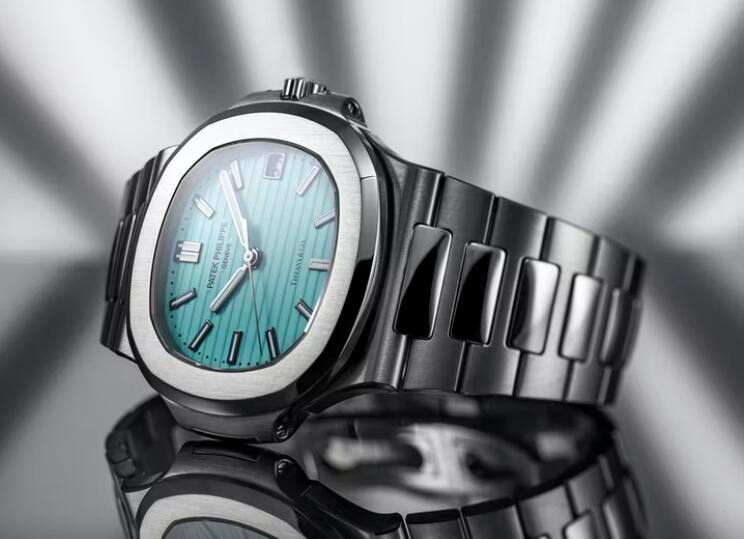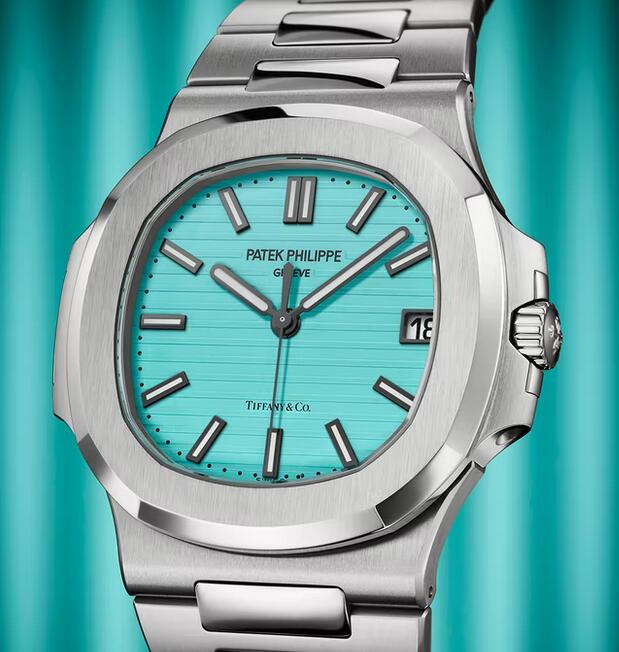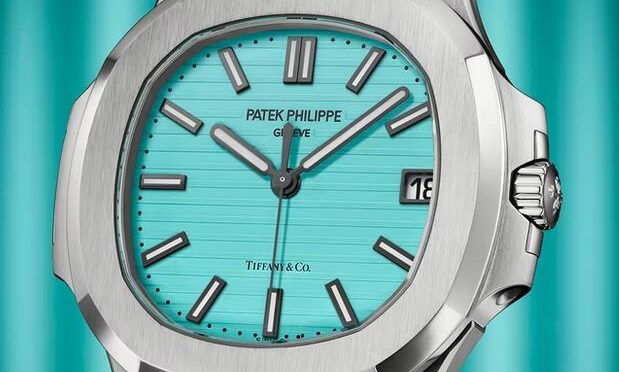Every watch that comes up for auction has at least two specific stories to tell. There’s the history of the watch itself and then there is the small matter of the price it actually sells for, which can influence secondary market conditions and even provide a bellwether of popular interest in the specific AAA US Patek Philippe replica watches, the collection as a whole, or even the brand itself. The winners are generally unidentifiable private individuals bidding over the phone or internet, and these stories conclude once the hammer – a proverbial curtain if there ever was one – has fallen.
One extraordinary exception has been our ongoing coverage of the Tiffany-Blue high quality fake Patek Philippe Nautilus 5711 watches that sold at Phillips New York last December for an awe-inspiring sum of more than $6.5 million, with the full total going to benefit The Nature Conservancy (TNC). Six weeks after we initially thought the story complete, we brought you the exclusive inside scoop on how one of the underbidders, a young collector named Zach (@zachattack__25), ended up with the watch. And today, I’m glad to be able to bring you what is likely the third and final act of this Tiffany Blue tale – a brief glimpse into where exactly all those millions of dollars went, and what good they’ve done for the world.
I spoke with David Banks, Chief Conservation Officer at The Nature Conservancy, to learn more about the company’s various projects and how exactly the $6.5 million sum has supported The Nature Conservancy’s global operations over the past five months.

What You Should Know About The Nature Conservancy
A common concern with charitable organizations is that donations get sucked up into salaries and overhead with little funds actually going toward the specific cause they’re promoting. We can safely say that The Nature Conservancy is one of the good ones. A quick look at the philanthropic watchdog site Charity Navigator gives TNC a “Give With Confidence” rating of 85/100, with a provided estimate of nearly 70 percent of donated funds going directly to program expenses. Charity Watch, a similar site, also ranks the organization highly, with a top rating of “A-” and an estimated figure of 75 percent of donations going directly to the charity’s specific programs. The remaining funds go toward salaries for the charity’s employees, overhead working capital, and other fundraising expenses.
The Nature Conservancy is based in Arlington, Virginia, but maintains affiliates and branches in more than 75 countries around the world. Since it was founded in 1951, TNC has had over one million members and supporters, enabling it to protect more than 119,000,000 acres of land and thousands of miles of rivers, worldwide.
“Our focus is on protecting lands and waters, and we do that in a way that is about tangible results for nature and for people,” says Banks, a 29-year veteran of The Nature Conservancy who worked his way up from an intern to now be the organization’s Chief Conservation Officer. (He rotates between a Casio and a Citizen on his own wrist, in case you’re curious.)
What Happened After The Auction
We knew going into the December 11, 2021, auction at Phillips HQ in New York that The Nature Conservancy was specifically selected as the beneficiary of the sale by Tiffany & Co. But what we didn’t know until speaking with Banks is just how supportive the New York jeweler has been in recent years. The relationship between TNC and Tiffany was born out of the work of former Tiffany CEO Michael J. Kowalski, a passionate environmentalist who is on the board for The Nature Conservancy’s Caribbean programs.
This specific project, however, was brokered between Tiffany & Co. and The Nature Conservancy’s fundraising department. It was completed so quickly and quietly – the perfect replica Patek Philippe watches was officially announced on December 6, less than a week before the auction took place – that most TNC team members, including Banks himself, weren’t aware of it until after the auction transpired. It goes without saying that they were shocked by the result.
“I know from talking to our development team, we were hoping we could get a good donation through the watch sale,” Banks says. “But I don’t think anyone anticipated that it would go for as high an amount as it did. I found out about it soon after the auction closed and just about fell off my chair. It was a good day.”
You might recall from our follow-up story that Zach (@zachattack__25) ended up purchasing the top copy watches for his final bid plus the commission – an approximate total of $6.2 million. At the time, Phillips confirmed to me that the original sum of $6.5 million sum would still be paid to The Nature Conservancy. Banks and TNC confirmed, once again, that the total figure they received from the auction was the original $6.5 million – and not a penny less.
“It’s off the charts, in terms of the amount that we were able to get through this auction and what that allows us to do,” Banks says. “Tiffany was adamant that they wanted the funds to go to our highest-priority conservation projects; they wanted it to help in a diverse set of places globally to get tangible results, particularly around the issues of addressing the protection of land and water for wildlife and nature, and then also to help us address the climate crisis. They came to us and asked, ‘What are some places that are important?’ So we proposed a number of places which they agreed were a high priority. We had quite a bit of back and forth on this. The way we decided to do it was to distribute these funds to projects currently in the field so they could move quickly on the work. I think most of these funds will be spent within the next year in order to get results on the ground.”
Working closely with Tiffany, five of The Nature Conservancy’s most important programs were selected to receive the funds. The organization’s operations in Papua New Guinea, Borneo, the Caribbean, and Alaska each received a total of $1,225,000, while TNC’s efforts in Belize received a slightly larger total of $1,603,000. Add it all up and you have the as-advertised $6,503,000 price that was originally achieved by Lot 1T at the Phillips New York Watch Auction Five.
“Tiffany wanted to make sure it was going to good projects in places that needed the funding, not the places that already had plenty of funding, in order to get tangible work done,” says Banks. “They listened to us instead of directing, which isn’t what always happens. We would love to do more of this kind of thing because it’s a really good story for conservation. Zach ended up with great luxury Patek Philippe replica watches and we’re able to do incredible work around the world. If we could do more of that, where everyone benefits, we’d be very interested.”
Here’s a closer look at each of the projects the funds are benefitting.

The Maya Forest In Belize: $1,603,000
The largest sum of money from the sale of the Swiss wholesale super clone Patek Philippe Tiffany Blue 5711 watches went to helping complete an acquisition of 236,000 acres of the Selva Maya tropical forest in northwestern Belize that includes some of the world’s most biodiverse tropical land.
“It helped us close out the conservation of a project in Belize,” Banks says. “We had acquired the property, and we needed just a little bit of extra money in order to finish paying off the acquisition costs. And so this topped that up, and allowed it to be completed.”
The Nature Conservancy teamed up with a diverse coalition of companies known as The Rainforest Trust to acquire and protect this parcel of land that represents nine percent of Belize’s total land area. It’s a place that’s particularly vulnerable to illegal logging and deforestation, not to mention the poaching of animals such as jaguars, ocelots, tapirs, and spider monkeys.
The Caribbean: $1,225,000
The Nature Conservancy currently operates in 17 countries and territories throughout the Caribbean region, making it one of the organization’s most prominent and lasting areas of focus. In fact, for more than 40 years, TNC has operated a base in the region focusing primarily on reef restoration, ocean protection, and the conservation of vulnerable coastal communities.
A few of TNC’s recent achievements in the Caribbean included helping declare five million acres of ocean and coastline in The Bahamas as a designated marine protected area, as well as opening a new coral science laboratory in the U.S. Virgin Islands to benefit ongoing reef restoration efforts.
One of the Nature Conservancy’s most notable works in the region was the Jack and Isaac Bay Preserve, established in the U.S. Virgin Islands in 1999. This 300-acre stretch of coastline was once intended for residential and commercial development before TNC acquired it to preserve the important coral reefs and to guard the nesting populations of the endangered sea turtles that flock to its beaches.
You can learn more about The Nature Conservancy’s recent accomplishments in the region through its Caribbean 2021 Impact Report.
Papua New Guinea: $1,225,000
“The funds [raised by the watch] will be used to fill gaps,” Banks says. “The cost of executing in places like Papua New Guinea or Borneo is really high, because of the remote nature and because we’re often actually acquiring concessions of land. So there’s a higher capital cost there that tends to go faster, but that’s also how we’re able to get these tangible results.”
The Nature Conservancy has maintained a conservation program focused primarily on sustainable development in Papua New Guinea for over 25 years. One example of their recent work there involves setting up and connecting a network of 10,000 local fishermen on the small island of Manus that both protects vulnerable fishing grounds and enables profit-sharing of harvested and sold sea cucumbers.
More recently, however, TNC has been investing in the protection of the Mangrove coastal forests through the establishment of Mangrove Market Women, a group that advocates for opportunities for local women through the protection of the mangrove forests.
“This money from Tiffany makes a huge difference for our teams in areas where there’s just no local support like what we have in the U.S,” Banks says. “They really need that outside support.”
Borneo: $1,225,000
Borneo is home to what are believed to be the oldest rainforests in the world. The Nature Conservancy has made a significant investment in protecting them over the years, primarily by buying timber concessions from the companies that own the right to log certain areas.
“What we’re doing is going in and buying these timber concessions from the timber companies and doing it in coordination with the government to keep the forest from being harvested,” Banks says. “These areas are very important for orangutans and other species. It’s also one of the most important places for carbon sequestration. These forests remove carbon from the air, but if they’re cut down, they’re not able to do that. So it’s really important to protect them for climate change and for species like orangutans.”
The Alaska Tongass National Forest: $1,225,000
The final program that will benefit from the funds raised by Tiffany, Patek, and Phillips is the Seacoast Trust Partnership that’s based out of Alaska’s Tongass National Forest. The Nature Conservancy has helped set up a fund for and has partnered with the indigenous communities located in Southeast Alaska to promote and provide sustainable, community-based economic development in the area.
“We partnered with the native community in Southeast Alaska to create what we’re calling the ‘Seacoast Trust,'” Banks says. “It’s a fund that supports forest conservation, as well as sustainable jobs and livelihoods in coastal Alaska and that will contribute toward the protection of biodiversity and addressing climate change. So we put a million dollars of the cheap fake watches sale into this fund that goes to protecting Southeast Alaska, which is a big priority for us and the community.”
The primary goal of the Seacoast Trust is to support the local population as their economy transitions away from relying on large-scale timber harvesting of the old-growth Tongass National Forest, which just so happens to be the largest intact coastal temperate rainforest in the world. A few of the programs in development that will be supported by the fund include the restoration of sustainable salmon runs, the establishment of new forest carbon projects, increasing local food security, developing regional energy independence, and empowering tribal authorities in the jurisdiction and conservation of local natural resources.
